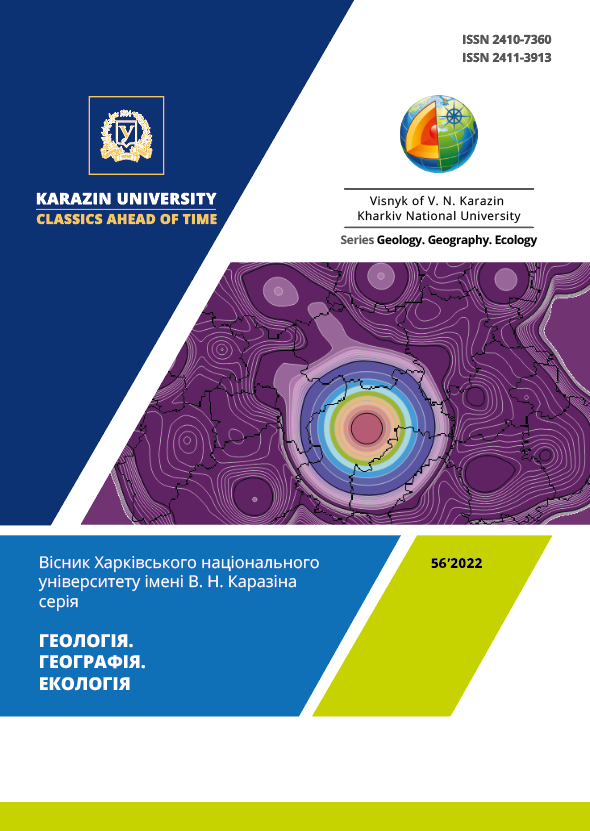Кліматичний моніторинг як індикатор гідрологічного стану басейну річки Сіверський Донець
Анотація
Вивчення впливу регіональних змін клімату на режим гідрологічних показників та екологічний стан басейну річки Сіверський Донець у межах Харківської області є актуальним, оскільки даний водотік із супутніми річками та іншими водними об’єктами є найважливішим джерелом води для східної частини України, особливо для урбанізованого міста Харків та промислового району Донбасу. Сучасні зміни температурно-вологісного режиму території відбиваються на гідрологічному стані річок, які стають маловодними та характеризуються погіршенням свого якісного стану. Враховуючи об’єми водокористування, які припадають на річку Сіверський Донець, виникає питання про водозабезпеченість регіону, оптимізацію його використання та подальше раціональне управління. Метою роботи виступає взаємозв’язок між кліматичними та гідрологічними показниками (оцінка динаміки екологічного стану) басейну Сіверського Дінця на тлі регіональних змін клімату. Моніторинг кліматичних, гідрологічних та екологічних показників дозволяє приймати подальші управлінські рішення щодо управління водними ресурсами під час кліматичних змін. Основними завданнями дослідження є визначення взаємозв’язків між кліматичними та гідрологічними показниками басейну річки Сіверський Донець та їх проєкцій. В результаті проведення кореляційного аналізу була підтверджена наявність сильного зв’язку між температурами повітря і води. У внутрішньорічному розподілі характерним є зміна коефіцієнта в залежності від співвіднесення ходу різних температур, тобто найсильніший зв’язок помітний влітку, коли температура стабілізується. Встановлено середній зв’язок між опадами та витратами води, оскільки хід витрат води навесні співпадає із мінімумом опадів, а влітку значну роль відіграють підземні джерела. Дослідження впливу змін кліматичних показників на гідрологічні дає можливість встановити стан еколого-гідрологічних умов річок за умов антропогенного навантаження на тлі подальших змін кліматичних показників, що матимуть різноспрямовані тенденції.
Завантаження
Посилання
Loboda N., Glushkov A., Khohlov V. (2005). Using meteorological data for reconstruction of annual runoff series over an ungauged area: Empirical orthogonal function approach to Moldova-Southwest Ukraine region. Atmos-pheric Research, 77/1-4, 100-113.
Loboda N., Glushkov A., Khohlov V. (2006). Using non-decimated wavelet decomposition to analyse time variations of North Atlantic Oscillation, eddy kinetic energy and Ukrainian precipitation. Journal of Hydrology, 323, 1-4, 14-24.
Khohlov V., Glushkov A., Loboda N. (2006). On the nonlinear interaction between global teleconnection patterns. Q. J. R. Meteor. Soc. 132, 447-465.
Hurrell J.W., Dickson R.R. (2003). Marine ecosystems and climate variation. Analysis and regionalization of north-ern European winter precipitation based on its relationship with the north atlantic oscillation / C.B. Uvo // Inter-national journal of climatology. 23, 1185-1194.
Loboda, N.S., Py`ly`p'yuk, V.V. (2017). Climate change and its important consequences in the formation of water quality (a case of the rivers Psyol and Vorskla). Bulletin of Odessa State Ecological University, 22, 69-79. [in Ukrainian]. Access mode: http://nbuv.gov.ua/UJRN/Vodeu_2017_22_10
On basic principles (strategy) of the state ecological policy of Ukraine for the period up to 2020: Approved by the Law of Ukraine of 21.12.2010 № 2818-VI. [in Ukrainian]. Access mode: http://zakon.rada.gov.ua/laws/show/2818-17
Reshetchenko, S.I., Kibalchich, I.A. (2014). Influence of processes in the North Atlantic on climatic indicators in Ukraine and Eastern Europe. Almanac of modern science and education, 4, 139-145. [in Russian]. Access mode: https://www.gramota.net/articles/issn_1993-5552_2014_4_38.pdf
Reshetchenko, S.I., Tkachenko, T.G., Ly`senko, O.G. (2015). Changing the temperature regime in the Kharkiv re-gion. Visnyk of V. N. Karazin Kharkiv National University, series "Geology. Geography. Ecology", 43, 153-158. [in Ukrainian]. doi: https://doi.org/10.26565/2410-7360-2015-43-24.
Reshetchenko S.I., Dmitriiev S. S., Cherkashyna N.I., Goncharova L.D. (2020). Climate indicators of changes in hy-drological characteristics (a case of the Psyol river basin). Visnyk of V. N. Karazin Kharkiv National University, se-ries "Geology. Geography. Ecology", 43, 153-158. [in Ukrainian]. doi: https://doi.org/10.26565/2410-7360-2020-53-12
AghaKouchak A., Chiang F., Huning L.S., Love C.A., Mallakpour I., Mazdiyasni O., Moftakhari H., Papalexiou S.M., Ragno E., Sadegh M. (2020). Climate Extremes and Compound Hazards in a Warming World. Annual Review of Earth and Planetary Sciences 48, 519-548. https://doi.org/10.1146/annurev-earth-071719-055228
Blöschl G., Hall J., Viglione A., Perdigão R. A., et al. (2019). Changing climate both increases and decreases Euro-pean river floods. Nature, 573, 108-111. https://doi.org/10.1038/s41586-019-1495-6
Blöschl G. et al. (2017). Changing climate shifts timing of European floods. Science, 357, 6351, 588-590. https://doi.org/10.1126/science.aan2506
Bernhofer C., Franke J., Goldber V., et al. (2006). Regional climate change: to be included in Future Flood Risk analysis? Flood Risk Management: Hazards, Vulnerability and Mitigation Measures. NATO Science Series, 67. doi: https://doi.org/10.1007/978-1-4020-4598-1_8
Gopchenko E. D., Ovcharuk V. A., Romanchuk M. E. (2015). A Method for Calculating Characteristics of Maximal River Runoff in the Absence of Observational Data: Case Study of Ukrainian Rivers. Water Resources, 42 (3), 285-291. Access mode: http://eprints.library.odeku.edu.ua/id/eprint/1567/1/wrj_42_2015_285.pdf
Gophenko Ye., Ovcharuk, V., Todorova O. (2016). Problems of the regulatory documents in calculating characteris-tics maximum runoff rivers of Ukraine and possible solutions. JOUR, 49-57. doi: 10.17072/2079-7877-2016-1-49-57
Gophenko E. D., Ovcharuk, V. A. Theoretical ground of normative base for calculation of the characteristics of the maximum runoff and its practical realization, Transboundary Floods: Reducing Risks Through Manag ment. NATO Sciences Series. IV Earth and Environ. Sci,72, 91–99. doi: https://doi.org/10.1007/1-4020-4902-1_9
Ovcharuk V., Hopchenko Ye. (2018). The modern method of maximum spring flood runoff characteristics valuation for the plain rivers of Ukraine. Ukrainian Geographical Journal, 2, 26-33. https://doi.org/10.15407/ugz2018.02.026
Ovcharuk V., Todorova O. (2016). Determination of characteristics maximal runoff Mountain Rivers in Crimea. J. Fundam. Appl. Sci., 8(2), 525-541. https://doi.org/10.4314/jfas.v8i2.23
S.I. Snizhko, O., Obodovskyi, O., Shevchenko, V., Grebin, Iu., Didovets, I., Kuprikov, O. (2020). Pochaievets. Region-al assessment changes of the rivers runoff of Ukrainian Carpathians region under climate changes. Ukrainian Ge-ographical Journal, 2, 20-29. https://doi.org/10.15407/ugz2020.02.020
Skrynyk, O., Osadchyi, V., Szentimrey, T., Bihari, Z., Sidenko, V., Oshurok, D., Boichuk, D., Skrynyk O. (2020). Spatial interpolation of climatological data with relief and physicogeographical peculiarities of the territory of Ukraine taken into account. Ukrainian Geographical Journal, 2, 13-19. https://doi.org/10.15407/ugz2020.02.013
Vasylenko E.V., Koshkina O.V., Maslova T.V. (2018). Hab-plot as the main unit of lakes hydromorphological moni-toring. Ukrainian Geographical Journal, 2, 34-37. https://doi.org/10.15407/ugz2018.02.034





